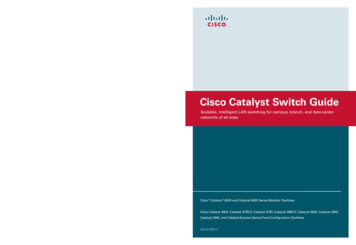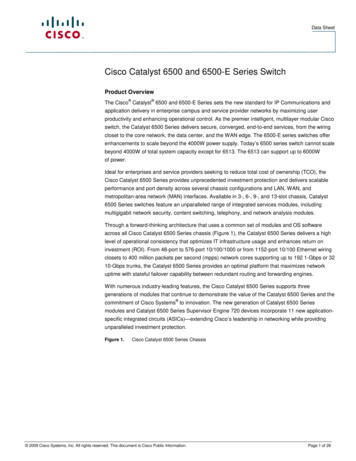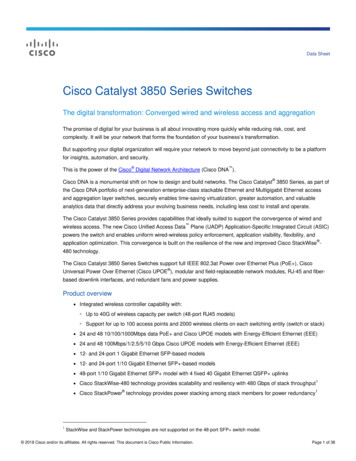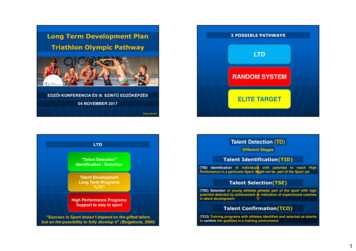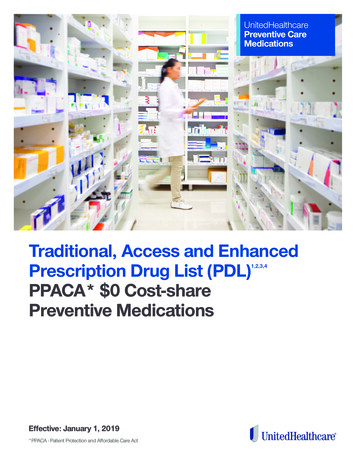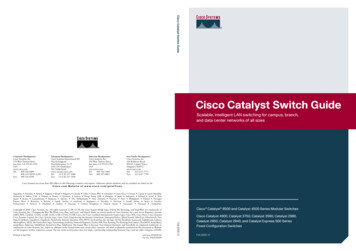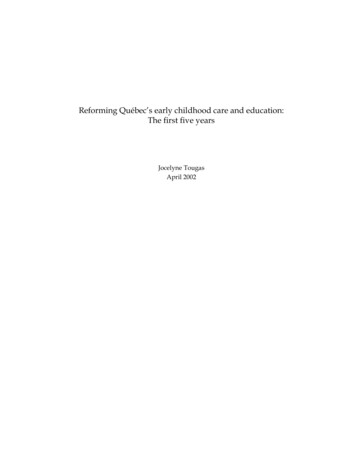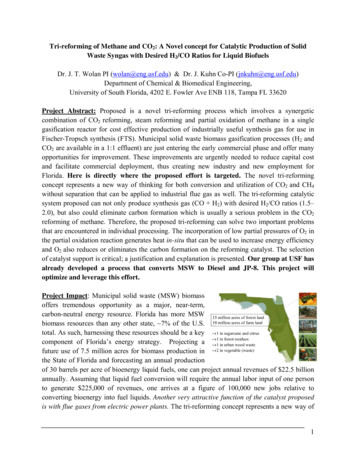
Transcription
Tri-reforming of Methane and CO2: A Novel concept for Catalytic Production of SolidWaste Syngas with Desired H2/CO Ratios for Liquid BiofuelsDr. J. T. Wolan PI (wolan@eng.usf.edu) & Dr. J. Kuhn Co-PI (jnkuhn@eng.usf.edu)Department of Chemical & Biomedical Engineering,University of South Florida, 4202 E. Fowler Ave ENB 118, Tampa FL 33620Project Abstract: Proposed is a novel tri-reforming process which involves a synergeticcombination of CO2 reforming, steam reforming and partial oxidation of methane in a singlegasification reactor for cost effective production of industrially useful synthesis gas for use inFischer-Tropsch synthesis (FTS). Municipal solid waste biomass gasification processes (H2 andCO2 are available in a 1:1 effluent) are just entering the early commercial phase and offer manyopportunities for improvement. These improvements are urgently needed to reduce capital costand facilitate commercial deployment, thus creating new industry and new employment forFlorida. Here is directly where the proposed effort is targeted. The novel tri-reformingconcept represents a new way of thinking for both conversion and utilization of CO2 and CH4without separation that can be applied to industrial flue gas as well. The tri-reforming catalyticsystem proposed can not only produce synthesis gas (CO H2) with desired H2/CO ratios (1.5–2.0), but also could eliminate carbon formation which is usually a serious problem in the CO2reforming of methane. Therefore, the proposed tri-reforming can solve two important problemsthat are encountered in individual processing. The incorporation of low partial pressures of O2 inthe partial oxidation reaction generates heat in-situ that can be used to increase energy efficiencyand O2 also reduces or eliminates the carbon formation on the reforming catalyst. The selectionof catalyst support is critical; a justification and explanation is presented. Our group at USF hasalready developed a process that converts MSW to Diesel and JP-8. This project willoptimize and leverage this effort.Project Impact: Municipal solid waste (MSW) biomassoffers tremendous opportunity as a major, near-term,carbon-neutral energy resource. Florida has more MSW 15 million acres of forest landbiomass resources than any other state, 7% of the U.S. 10 million acres of farm landtotal. As such, harnessing these resources should be a key # 1 in sugarcane and citrusresiduescomponent of Florida’s energy strategy. Projecting a ## 11 inin foresturban wood wastefuture use of 7.5 million acres for biomass production in # 2 in vegetable (waste)the State of Florida and forecasting an annual productionof 30 barrels per acre of bioenergy liquid fuels, one can project annual revenues of 22.5 billionannually. Assuming that liquid fuel conversion will require the annual labor input of one personto generate 225,000 of revenues, one arrives at a figure of 100,000 new jobs relative toconverting bioenergy into fuel liquids. Another very attractive function of the catalyst proposedis with flue gases from electric power plants. The tri-reforming concept represents a new way of1
thinking both for conversion and utilization of CO2 and CH4 in effluent biomass gasificationwithout separation, and for production of industrially useful synthesis gas with desired H2/COratios for FTS.Dissemination and Technical Commercialization: Disseminating knowledge gained throughpublications in refereed journals and presentations at local, national and international meetings isparamount. Past performance in this respect attests to this commitment. Targeted conferencesinclude MRS, AVS, ACS, AIChE and others are suitable and anticipated. Technical andtechnology commercialization will be pursued via the USF Office for Technology Developmentand the Clean Energy Research Center (CERC) at USF to develop, evaluate and promotecommercialization of new environmentally clean energy sources and systems.Timeline & onthComplete191Experimental Studies onBio-gasifier generatedsyngas composition2Development and design 3of the tri-reforming Nibased catalyst system113Optimization of catalyst 4utilizing a PFR withcontrolled feedExperimental studies6utilizing actual biomassgenerated syngas1245Commercial Scale PlantDesign and EconomicProfitability Study61212Deliverables/ OutputsYield and kinetic dataon biomass gasification,and overall economicfeasibilityCharacterization andactivity analysis of thedeveloped catalyticsystemInitial yield andcomposition data onH2:CO ratios obtainedYield and compositiondata on H2:CO ratiosobtained, catalystactivity and lifetimePlant Design Report andSensitivity StudiesDeliverable/ OutputDue Dates9th month11th month12th month12th month12th monthExisting Collaborators and External Support: The PI’s are currently working in partnershipwith several academic as well as commercial collaborators. These include Drs. B. Joseph, Y.Goswami, V. Gupta, N. Alcantar, C. Miller, V. Bhethanabotla, and others at USF along with2
Helena and Jason Weaver at UF. Commercial and national laboratory collaborators include TinoPrado of Prado engineering, Derek Benson of Catalyst Renewables, Shaun Reeve of Bio Energy,Inc., and Matt Yung, NREL and Paul Matter of PH Matter, and Justin Wang of Sud Chemie.External support currently consists of pending proposals to NSF and DOE. Proposals toNSF for the MURI and RESTOR programs have and/or will be submitted in the next fewmonths.Where we are now Currently we have optimized a novel Fischer-Tropsch (FT) Co/SiO2 catalyst and reactor designthat is tunable, producing diesel and J-P8 jet fuel as shown in fig 1 below. We can produce anyhydrocarbon cut required, from gasoline to jet fuel using biomass derived synthesis gas. Fig 2shows a schematic of the FT process. Our current source of syn gas is pine chips, however, anybiomass feed stock can be utilized; from municipal waste, demolition waste, animal waste, etc.The problem lies with the resulting composition of syn gas produced biomass. A 2:1 H2: COsyngas composition in required for optimal performance. Biomass derived syn gas has a typicalH2: CO ratio of 1-1.3:1.Fig 1: GC results of product using 2:1 H2:CO enriched biomass derived hydrocarbon fuel.Note the tight hydrocarbon distribution.3
Fig 2. A schematic of the overall Fischer Tropsch processFig 3 shows our fuel product in stages of increasing H2 concentration to the biomass derived syngas up to the 2:1 optimum ratio. One can clearly see the optimized product at the far right has nophase separation and was used to produce the GC results of fig. 1. Conclusion; the H2:CO ratiofor biomass derived syn gas must be brought up to the optimal 2:1 ratio for best possibleproduct results. What is need is a catalytic system where upon gasification of the biomass, a 2:1H2: CO syn gas is directly produce so that enrichment with hydrogen is no longer required.Fig 3. Fuel samples 1-7 showing the change in phase separation as the optimal 2:1 H2:COratio is reached. Sample #7 is the resulting optimized fuel as seen in the GC results of Fig 1.4
In addition, our technology was showcased at the 2010 Global Venture Challenge held at OakRidge National lab where the technology placed second in the US. Our team picture is shownbelow.Project Description: Statement of purpose: The purpose of this effort is to eliminate a currentbottleneck in the development of non-feedstock biomass gasification systems to produce anoptimal H2: CO ratio of 2:1 for Co-based FTS. Typical biomass syngas analysis is H2 32.7%, CO42.5%, CO2 19.6% and CH4 5.2% (mol % dry-basis) as a result, the H2: CO ratio isapproximately 1:1 [1]. Hypothesis: By exploiting this mixture, one can increase the H2: COratio via the development and optimization of a novel tri-reforming catalyst process. This is asynergetic combination of CO2 reforming, steam reforming, and partial oxidation of methane in asingle gasification reactor for effective production of industrially useful synthesis gas (syngas).The CO2, H2O, CH4, and O2 in the exit gas need not be pre-separated because they will beused as co-reactants for tri-reforming. The novel tri- reforming, as proposed, has the potential5
to be performed within the biomass gasification stage as the temperatures, conditions, andconstituents are optimal.Program Objectives: (1) Synthesize and develop a cost effective joint tri-reforming catalyticsystem capable of producing non-feedstock syngas with desired H2: CO ratios of 2:1complimentary to ongoing FTS at the University of South Florida. (2) Evaluate catalystreducibility, activity and attrition. (3) Plant design including mass and energy balance usingactual non-feedstock biomass generated syngas and (4) Evaluate the environmentalburden/advantages and identify technological innovation opportunities.Background and Significance: CO2 and CH4 conversion and utilization are an importantcomponent in chemical research on sustainable development; not only due to greenhouse issuesbut because CO2 and CH4 also represent an important source of carbon for fuels and chemicalfeedstock in the future [1–3]. The prevailing thinking for CO2 conversion and utilization beginswith the use of pure CO2, which can be obtained by separation. Even the recovery of CO2 fromconcentrated sources requires substantial energy input [4,5]. According to US DOE, current CO2separation processes alone require significant amount of energy which reduces a power plant’snet electricity output by as much as 20% [4,6]. Proposed in a novel method where CO2generated via biomass gasification can be utilized in one step by novel tri-reforming. However,there are two serious problems: deactivation of the catalyst by carbon formation andconsumption of high energy due to endothermic processes (Eq. 1).CH4 CO2 2CO 2H2ΔHo298 247.3 kJ/mol(1)During commercial dry reforming, several side reactions of coke formation occur simultaneously(Eqs. (2) and (3))ΔHo298 74.9kJ mol(2)CH4 C 2H22CO C CO2ΔHo298 - 172.2 kJ mol(3)Comparatively, the proposed joint tri-reforming process is far superior over current dryreforming both thermodynamically and in the elimination of carbon (coke) formation. Joint trireforming is a combination of endothermic CH4 reforming (Eq. (1)), steam reforming (Eq. (4))and exothermic oxidation of CH4 (Eqs. (5) and (6)), which have a greater impact in regard toboth industrial and environmental aspects [7-9].CH4 H2O CO 3H2ΔHo298 206.3kJ/mol(4)6
CH4 ½ O2 CO 2H2ΔHo298 -35.6 kJ/mol(5)CH4 2O2 CO2 2H2OΔHo298 - 880.3kJ/mol(6)RESEARCH APPROACHThe proposed investigation has been designed to enhance and expand funded research in thisarea, as well as exploiting PI’s prior work [10-14] and collaborations established under theBinational Science Foundation with the Tel Aviv University and Weizmann Institute of Scienceand NREL. A support letter from Dr. Matthew M. Yung at NREL is attached.Experimental: Various supported Ni catalysts will be prepared in our laboratory for trireforming in the proposed work. The supports include CeO2, ZrO2, MgO, SiO2 and Al2O3,prepared using the soft chemistry technique reported by Rossigonol et al. [15] with Ce(NO3)3 6H2O and Zr(OCH2CH2CH3)4 as the precursors. Ni will be dispersed on these supports by wetimpregnation method using nickel nitrate Ni(NO3)2 -6H2O under agitation for 1 h, followed bydrying in an oven at 60 oC overnight. The dried solid will then be ground into power andcalcined at 870 oC for 6 h in air. The Ni/MgO/CeZrOx catalyst will be prepared by the sameprocedures as described above except Mg(NO3)2-6H2O (99% purity) was used as the precursorof MgO and both Ni(NO3)2-6H2O and Mg(NO3)2-6H2O will be dissolved into distilled H2O toform an aqueous solution. The weight percentage of MgO in the Ni/MgO/CeZrO catalyst will beca. 10 wt.%. A commercial Ni-Al2O3 catalyst (ICI Synetix 23-4,R15513) and mesoporous SiO2supported catalysts will also tested for comparison.The supports were selected based on the following considerations: Supports with basicproperties and/or high oxygen storage properties may promote the adsorption of CO2 on catalystsand, consequently, enhance the CO2 conversion. Based on a simplified mechanism of CO2conversion in the CO2 reforming reaction [16-18], the reaction starts from the activation ofmethane followed by the surface reaction with surface CO2 species or adsorbed oxygen atomsderived from CO2 (CO2 * CO O*, * denotes an active site). Compared with H2O and O2,CO2 is more acidic. Basic supports may preferentially interact more strongly with CO2 than H2Oand O2. Once CO2 is adsorbed on the catalyst surface, it may have more chance to react with CH4and form CO and H2. Similarly, supports with more oxygen storage capacity may facilitate thedissociative adsorption of CO2 into CO and adsorbed oxygen by CO2 * CO O*, leading tothe enhanced conversion of CO2. MgO is a basic support which has been reported for CO2reforming [19–22], steam reforming [23,24], and methane partial oxidation [25]. However, noreports have been found on the comparison of CO2 conversion in the presence of H2O and O2 asin the proposed tri-reforming process. The H2/CO ratio in the products is related to theconversion of H2O, CO2, and O2. The mixed oxide of Ce and Zr has been reported to have alarger oxygen storage capacity although the oxygen storage capacity of CeO2 and ZrO27
themselves is very little [24]. The application of this material has not yet been studied in trireforming, although similar support material has been tested by Roh et al. [23] in oxy-steamreforming. CeO2 and ZrO2 were chosen as supports for the purpose of 10][11][12][13][14]CO2 Conversion and Utilization,C. Song, A.M. Gaffney, K. Fujimoto (Eds.), ACS Symp.Ser.American Chemical Society, Washington, DC,2002.(a)M.M. Halmann, M. Steinberg, Greenhouse Gas Carbon Dioxide Mitigation:Science and Technology, Lewis Publishers, Boca Raton, FL, 1999; (b)H.Gunardson, Industrial Gases in Petrochemical Processing, Marcel Dekker, New York,1998.M.M. Maroto-Valer, C. Song, Y. Soong (Eds.), Environmental Challenges andGreenhouse Gas Control for Fossil Fuel Utilization in the 21st Century, KluwerAcademic/Plenum Publishers, New York, 2002.DOE/OS-FE, Carbon Sequestration, State of the Science, Office of Science and Office ofFossil Energy, US DOE, 1999. DOE/FE, Capturing Carbon Dioxide, Office of FossilEnergy, US DOE, 1999.T. Weimer, K. Schaber, M. Specht, A. Bandi, Am. Chem. Soc. Div. Fuel Chem. Prepr. 41(4) (1996) 1337.DOE/FE, Capturing Carbon Dioxide, Office of Fossil Energy, US DOE, 1999.C. Song, Chem. Innov. 31 (1) (2001) 21.W. Cho, Y. Baek, S.K. Moon, Y.C. Kim, Catal. Today 74 (2002) 207–223.C. Song, W. Pan, Catal. Today 98 (2004) 463–484.A.H. Kababji, B. Joseph, J.T. Wolan; “Silica-Supported Cobalt Catalysts for Fischer–Tropsch Synthesis: Effects of Calcination Temperature and Support Surface Area onCobalt Silicate Formation;” Catal. Lett (2009) 130: 72-78Kuhn, J.N., Zhao, Z., Felix, L.G., Slimane, R.B., Choi, C.W., and Ozkan, U.S., “Olivinecatalysts for methane- and tar-steam reforming”, Applied Catalysis B: Environmental 81(2008) 14-26.Kuhn, J.N., Tsung, C.-K., Huang, W., and Somorjai, G.A., “Effect of capping agent uponactivity for ethylene hydrogenation and carbon monoxide oxidation over platinumnanoparticles supported on mesoporous silica”, Journal of Catalysis 265 (2009) 209-215.Kuhn, J.N., Lakshminarayanan, N., and Ozkan, U.S., “Effect of hydrogen sulfide on thecatalytic activity of Ni-YSZ cermets”, Journal of Molecular Catalysis A: Chemical 82(2008) 9-21.Kuhn, J.N., Zhao, Z., Senefeld-Naber, A., Felix, L.G., Slimane, R.B., Choi, C.W., andOzkan, U.S., “Ni-olivine catalysts prepared by thermal impregnation: structure, steamreforming activity, and stability”, Applied Catalysis A: General 341 (2008) 43-49.8
[15][16][17][18][19][20][21][22][23][24][25]S. Rossigonol, Y. Madier, D. Duprez, Catal. Today 50 (1999) 261.M.F. Mark, F. Mark, W.F. Maier, Chem. Eng. Technol. 20 (6) (1997) 361.V.C.H. Kroll, H.M. Swaan, S. Lacombe, C. Mirodatos, J. Catal. 164 (2)(1997) 387.J.R. Rostrup-Nielsen, J.H. Bak Hansen, J. Catal. 144 (1993) 38.K. Tomishige, Y. Chen, X. Li, K. Yokoyama, Y. Sone, O. Yamazaki, K.Fujimoto, Advances in chemical conversions for mitigating carbon dioxide, Stud. Surf.Sci. Catal. 114 (1998) 375.J. Nakamura, K. Aikawa, K. Sato, T. Uchijima, Catal. Lett. 25 (3–4)(1994) 265.E. Ruckenstein, Y.H. Hu, Appl. Catal. A 133 (1) (1995) 149.Y.H. Hu, E. Ruckenstein, Catal. Lett. 43 (1–2) (1997) 71.H.S. Roh, K.W. Jun, W.S. Dong, S.E. Park, Y.S. Baek, Catal. Lett. 74(1–2) (2001) 31.O. Yamazaki, K. Tomishige, K. Fujimoto, Appl. Catal. A 136 (1)(1996) 49.E. Ruckenstein, Y.H. Hu, Ind. Eng. Chem. Res. 37 (5) (1998) 1744.9
DR. JOHN T. WOLANEducation: Ph.D. University of Florida, June 1998; M.S .University of Florida, January, 1996; B.S.Chemistry, University of Central Florida, May 1981Employment20052002-20051998-20011986-1998- Associate Professor of Chemical Engineering, USF, Tampa- Assistant Professor Chem. Engg., Univ. of S. Florida, Tampa-Assistant Professor of Chemical Engineering, Mississippi State University- Lecturer and Research Associate, Department of Chemical Engineering, UF.Awards and HonorsHonorable mention at the 2010 Global Venture ChallengeElected Director of Materials Science and Engineering Program, University of South Florida, 2009Engineering Professor Research Award, University of South Florida, 2004Engineering Professor of the Year, Mississippi State University, 2001"Best Graduating Chemical Engineer", University of Florida, 1998Selected PublicationsA.H. Kababji, B. Joseph, J.T. Wolan; “Silica-Supported Cobalt Catalysts for Fischer–Tropsch Synthesis:Effects of Calcination Temperature and Support Surface Area on Cobalt Silicate Formation;” Catal. Lett(2009) 130: 72-78Jonathan Mbah, Burton Krakow, Elias Stefanakos, and John T. Wolan, “A Study on H2S Permeability ofCsHSO4 Membrane”, International Journal of Hydrogen Energy; 34 (5) 2009, 2460-2466Jonathan Mbah, Burton Krakow, Elias Stefanakos and John Wolan "Influence of High Energy PlanetaryMilling on the Ionic Conductivity of CsHSO4", Electrochem. Solid-State Lett., Volume 12, Issue 7, pp.E12-E16 (2009)Elias Stefanakos, Burton Krakow, Jonathan Mbah, and John T. Wolan: "Hydrogen Production fromHydrogen Sulfide in IGCC Power Plants", (DOE Information 36518TA.H. Kababji and J.T. Wolan, “Porous silicon Carbide and Gallium Nitride; “SiC Catalysis Today,” bookchapter 10, Wiley Press, editors Randall M. Feenstra and Colin Woods, ISBN 978-0-470-51752-9,copyright 2008 Wiley Press & Sons Ltd.46 scholarly articles in refereed journalsMore than 50 technical presentations at national and international conferences12 Invited technical seminars at major universities18 Graduate students supervisedConsultant to industry and government10
DR. JOHN N. KUHNEDUCATION & PROFESSIONAL EXPERIENCE2009-present Assistant Professor of Chemical and Biomedical Engineering, USF2007–2009Postdoctoral Fellow in Chemistry, University of California, Berkeley (joint appointmentwith Lawrence Berkeley National Laboratory in Divisions of Chemical Sciences andMaterials Sciences)POSTDOCTORAL SPONSORProf. Gabor A. Somorjai; University of California, Berkeley and Lawrence Berkeley NationalLaboratory; (510)-642-4053; somorjai@berkeley.edu2002-2007Doctor of Philosophy in Chemical Engineering, Ohio State UniversityPh.D. ADVISORProf. Umit S. Ozkan; Ohio State University; (614) 292-6623; ozkan.1@osu.edu2001-2002Research Assistant in Materials and Manufacturing Directorate at Air Force ResearchLaboratories, Wright-Patterson Air Force Base1998-2002Bachelor of Science in Chemical Engineering, University of DaytonSELECTED PUBLICATIONS1. Kuhn, J.N., Huang, W., Tsung, C.-K., Zhang, Y., and Somorjai, G.A., “Structure sensitivity of carbonnitrogen ring opening: Impact of platinum particle size from below 1 to 5 nm upon pyrrole hydrogenationproduct selectivity over monodisperse platinum nanoparticles loaded onto mesoporous silica”, Journal ofthe American Chemical Society 130 (2008) 14026-14027.2. Kuhn, J.N., Zhao, Z., Felix, L.G., Slimane, R.B., Choi, C.W., and Ozkan, U.S., “Olivine catalysts formethane- and tar-steam reforming”, Applied Catalysis B: Environmental 81 (2008) 14-26.3. Kuhn, J.N., Tsung, C.-K., Huang, W., and Somorjai, G.A., “Effect of capping agent upon activity forethylene hydrogenation and carbon monoxide oxidation over platinum nanoparticles supported onmesoporous silica”, Journal of Catalysis 265 (2009) 209-215.4. Kuhn, J.N., Lakshminarayanan, N., and Ozkan, U.S., “Effect of hydrogen sulfide on the catalyticactivity of Ni-YSZ cermets”, Journal of Molecular Catalysis A: Chemical 82 (2008) 9-21.5. Kuhn, J.N., Zhao, Z., Senefeld-Naber, A., Felix, L.G., Slimane, R.B., Choi, C.W., and Ozkan, U.S.,“Ni-olivine catalysts prepared by thermal impregnation: structure, steam reforming activity, andstability”, Applied Catalysis A: General 341 (2008) 43-49.6. Kuhn, J.N., and Ozkan, U.S., “Surface properties of Sr-and Co-doped LaFeO3”, Journal of Catalysis253 (2008) 200-211.7. Tsung, C.-K., Kuhn, J.N., Huang, W., Aliaga, C., Hung, L.-I., Somorjai, G.A., and Yang, P. “Sub-10nm platinum nanocrystals with size and shape control: Catalytic study for ethylene and pyrrolehydrogenation”, Journal of the American Chemical Society 131 (2009) 5816-5822.8. Zhang, Y., Grass, M.E., Kuhn, J.N., Tao, F. Habas, S.E., Huang, W., Yang, P., and Somorjai, G.A.,“Highly selective synthesis of catalytically active monodisperse rhodium nanocubes”, Journal of theAmerican Chemical Society 130 (2008) 5868-5869.9. Zhao, Z., Kuhn, J.N., Felix, L.G., Slimane, R.B., Choi, C.W., and Ozkan, U.S., “Thermallyimpregnated Ni-olivine catalysts for tar removal by steam reforming in biomass gasifiers”, Industrial &Engineering Chemistry Research 47 (2008) 717-723.11
Budget Justification:Senior Personnel: One-month and half-month summer salaries over the 12 month period arebudgeted for the PI (Wolan) and Co-PI (Kuhn) respectively. This time is in recognition ofstudent direction, mentoring and guidance as well as hands on experimentation.Student Support: One graduate and two undergraduate students are budgeted for 12 monthappointments. Several other graduate students work with the research groups of the faculty PIsof this proposal, and their involvement is implicitly assumed, although not budgeted here.Domestic Travel: Travel funds at 1,000 are budgeted for the USF faculty and their student toattend Hinkley Center reviews.Materials, Supplies and Instrument Time: Funds are requested for consumable chemicals andlaboratory supplies, reagents, etc. (as needed) metrology instrument time (XPS, XRD, and SEM),shop fabrication costs, and such. Projects are charged an hourly rate for shared facilities at asubsidized rate for the College of Engineering.Graduate Student Tuition: In-state tuition for the one graduate student is requested at the rateof 321 per credit hour for a total of 24 credits per student. Out-of-state portion is about threetimes more, and a tuition waiver will be requested through the College of Engineering in case thestudents are not Florida residents.12
College of Engineering Research Proposal BudgetProject Duration (in Years) A. SENIOR PERSONNEL: PI, Co-PIs, Other Senior Personnel, etc.YEAR1 1/ 21FundsIdentify Months FundedFirst NameLast NameTitleJohnKuhnPIJohnWolanPICo-PICo-PICo-PIBase Salary Months Appt'd Monthly Rate Annual Inflation Rate9 8,778 79,0003%9 11,144 100,2929 0 09 09 0Requested byi.e. ACAD or SUM ProposerIdentify # of Months Funded 0.5 4,3890.5 5,5720.0 00.0 00.0 0 9,961B. OTHER PERSONNEL1. POST DOCTORAL ASSOCIATES0Identify # of Months Funded 2. OTHER PROFESSIONALS (non-clerical)0Identify # of Months Funded 3. GRADUATE STUDENTS25. ADMINISTRATIVE - MUST justify0ACADSUM0.00.00.00.00.00.0Will grant pay for summer classes? (Y or N)1.04. UNDERGRADUATE STUDENTSCAL 0 0 22,000y 2,000Identify # of Months Funded 0.00.0 00.0TOTAL SALARIES AND WAGES (A B) 33,961 2,066C. FRINGE BENEFITSInsurance Costs - Individual 449 p/ mo, family 948 p/ mo. ONLY include for summer months if 12 month appointment 0Research Assistant insurance costs - 1385 full yr/ 154 monthlytotal FB 1,385TOTAL SALARIES, WAGES AND FRINGE BENEFITS (A B C) 3,451 37,411D. PERMANENT EQUIPMENT (LIST ITEM AND DOLLAR AMOUNT FOR EACH ITEM 1,000 OR GREATER)Yr1Yr2Yr3Yr4Yr5 0 0 0 0 0 0 0 0 0 0 0 0 0 0 0 0 0 0 0 0TOTAL EQUIPMENT 1,000E. TRAVEL 1. DOMESTIC (INCL. CANADA, MEXICO AND U.S. POSSESSIONS)2. INTERNATIONAL 0F. PARTICIPANT SUPPORT COSTS (Costs related to workshops or special programs)1. STIPENDS2. TRAVEL3. SUBSISTENCE4. OTHERTOTAL NUMBER OF PARTICIPANTS 0G. OTHER DIRECT COSTS1. RESEARCH RELATED MATERIALS AND SUPPLIES 10,0002. PUBLICATION, DOCUMENTATION, AND DISSEMINATION COSTS 03. CONSULTANT SERVICES 04. COMPUTERS SERVICES - Related to access fees for special databases, etc. 05. SUBAWARDS - (identify)6. OTHER 0WAIVER RATE P/HRTUITIONENTER RATE IN 332Out 819332819IN OUT#Students 1.00#Hours24 7,9686. OTHER 06. OTHER 0TOTAL OTHER DIRECT COSTS 17,968 56,379H. TOTAL DIRECT COSTS (A THROUGH G)I. F&A (INDIRECT) COSTS - SPECIFY RATEBaseRateF&A Costs 48,4110%yr2 00% 0yr3 047% 0yr4 047% 0yr5 047% 0yr1 Modified TDC 0TOTAL F&A COSTSJ. TOTAL DIRECT AND F&A COSTS (H I)K. RESIDUAL FUNDS (IF FOR FURTHER SUPPORT OF CURRENT PROJECTS)L. AMOUNT OF THIS REQUEST (J) OR (J MINUS K)M. COST SHARING: PROPOSED LEVEL - MUST be pre-approved by Dept Chair, Associate Dean for Research, and Dean 0 56,379 0 56,379 013
6 to be performed within the biomass gasification stage as the temperatures, conditions, and constituents are optimal. Program Objectives: (1) Synthesize and develop a cost effective joint tri-reforming catalytic system capable of producing non-feedstock syngas with desired H2: CO ratios of 2:1 complimentary to ongoing FTS at the University of South Florida.

